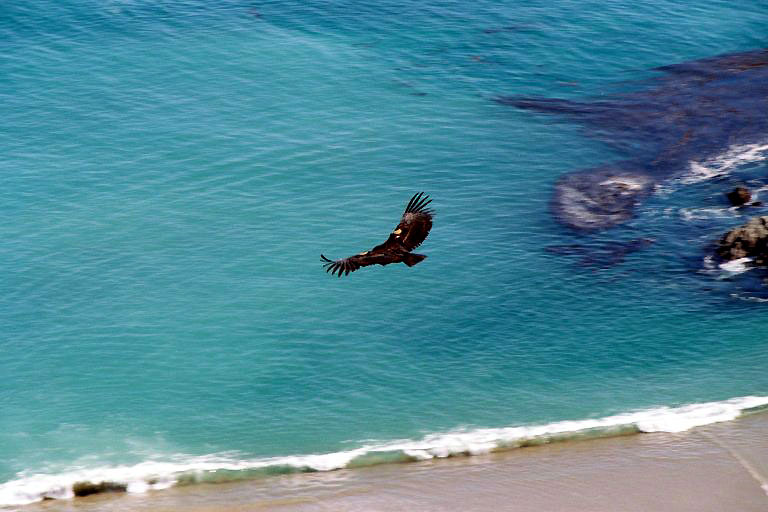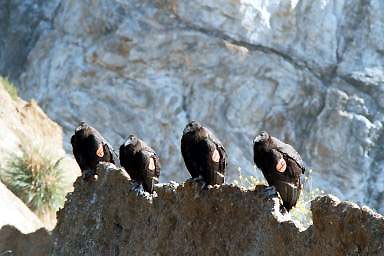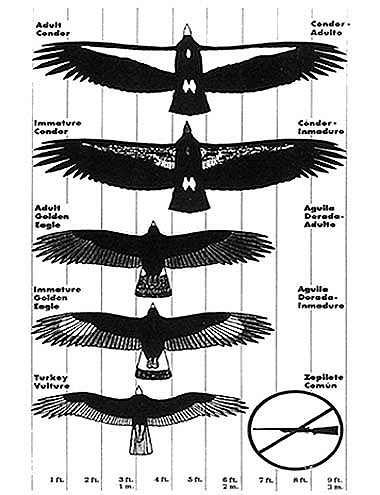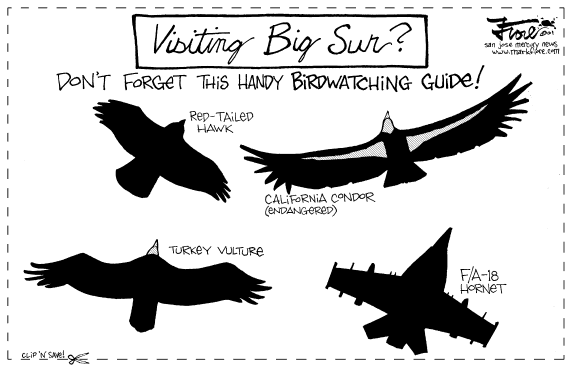 |
|
||||||||||||||||||
View this PBS Special; Condors vs. Lead Bullets
Full frame viewing here: http://www.kqed.org/quest/television/view/93
Pair of california condors found nesting in Big Sur
``For the past 10 years when this sort of thing came up, it turned out to be just in my dreams,'' said Kelly Sorenson, the group's executive director. ``Now it is a reality.'' The non-profit group began releasing condors into the wild in 1997. It now monitors a population of 38 condors in Central California, but this is the first time a condor nest has been found in the northern part of the state. ``This is that next step that we've been waiting for,'' Sorenson said. ``The goal is that they feed on their own and breed on their own -- and now and they're beginning to do both.'' About 10 chicks have been born in the wild in Ventura County and Arizona, but only one has survived. The bird, living in Ventura County, is now almost two years old. Although the condor recovery effort has increased the number of birds tenfold in the past two decades, there have been other significant setbacks as well. About 40 percent of released condors have died from lead poisoning, hitting power lines and attacks by golden eagles. The mortality rate in Big Sur, however, has been much lower -- raising hopes that birds born there will live to ripe old ages. Only nine of 41 condors released there have died. Sorenson theorizes it's because there are fewer power lines, fewer hunters (whose lead bullets kill condors when they munch on carcasses) and more dead marine mammals for the vultures to feast on. The last known condor egg in Northern California was collected in 1905 in Monterey County, Sorenson said.
Joe Burnett, a senior wildlife biologist at the society, said the couple was spotted Monday morning engaging in typical condor nesting behavior, with the male and female taking turns guarding the nest every two or three days, never leaving the nest unattended for more than a couple of minutes at a time. ``Although the view into the cavity is very limited and we can't actually see the egg, we strongly suspect they have an egg based on their behavior at the nest site,'' he said. Sorenson said the condors ``wouldn't be exhibiting this kind of behavior if there weren't an egg in there.'' The society is keeping the exact location of the nest secret to make sure no one disturbs the couple, he said. Biologists will carefully check out the egg in the coming days to make sure it is fertile. The male bird, 9-year-old Condor No. 167, was hatched at the Los Angeles Zoo and released in Big Sur by the society in late 1997. Its mate, 8-year-old Condor No. 190, born in the same zoo, was released in early 1999 in Big Sur. Cousins of the turkey vulture, thousands of California condors once flew from British Columbia to Mexico before declining precipitously in population during the Gold Rush. They reached a low in the 1980s, when the population fell to just 27 birds. Desperate biologists captured all remaining wild condors in 1987 and began breeding them in zoos. U.S. Fish and Wildlife Service biologists began releasing them to the wild in 1992. The Ventana Wildlife Society and Peregrine Fund began releasing them several years later. Today the population of California condors has grown to more than 275. Of those, about 125 live in the wild at Big Sur, Pinnacles, Ventura County and the Grand Canyon, with a few in Baja California, Mexico. The rest live in captivity at the Los Angeles Zoo, San Diego Wild Animal Park and other facilities. ``This nest puts us one step closer to our goal of having 150 condors in the wild with 15 breeding pairs,'' Sorenson said. http://www.ktvu.com/news/8344923/detail.html
This quicktime movie, "condorcan" shows many of the difficulties Ventana Wildlife Society has in managing the reintroduction of the California condor in Big Sur. It's a little difficult to tell but the condor is picking at an aluminum can that someone has littered on the Big Sur hillside. This can be a deadly event for a condor. The other great issue at hand is people getting too close to the condors. They like to perch along cliffs and this particular cliff offers the view of a seal rookerie which supplies them with food. Humans encroach innocently upon the condors but his can alter the effectiveness of making the condor adapt to its environment. It also is beginning to create a dangerous setting for people and for the condor along the highway.
This footage is of condor #9 cleaning itself. Once again, people encroaching on the condor create highway risks and habituate the condor to humans. This videographer is guilty of the same but took the opportunity to illustrate the difficulty Ventana Wildlife Society has in its effort to save this species. If you have trouble with this format try viewing the Condor Cleaning video HERE If you have trouble viewing this video format, try viewing it HERE This movie also shows the perils of the popularity of the California condor. As amazing as they are to watch, you can see the problem with them catching updrafts along the highway in Big Sur. We ask that you try to keep your distance whenever possible. These are quicktime movies. If you are having trouble viewing them, please download the latest quicktime player here. Macintosh or Windows If you would like to help in this effort to reintroduce condors please contact the Ventana Wildlife Society.
California condors, Gymnogyps californianus, are currently being reintroduced to the central coast by the Ventana Wildlife Society, which is a non-profit, 501(c)3, organization. The Society is dedicated to the preservation of native plants and animals through research, education, and restoration. By the efforts of the Ventana Wildlife Society, Condors are now seen throughout the mountains, coastal canyons and valleys of Big Sur. You can help in these efforts by donating time or money. Please contact the Ventana Wildlife Society directly if you would like to help. At the turn of the century, the California condor (Gymnogyps californianus) population began to plummet after decades of wanton shooting and poisoning. While habitat loss is a factor and limits the total population, the habitat that remains is still intact to sustain a population of condors. In 1987, the last wild condor was taken into captivity to join 26 others. A successful captive breeding and reintroduction program turned the tide. In 1998, the total population reached 150 birds, and 35 of those were in the wild. Given the success of bald eagle reintroduction, Ventana Wildlife Society was requested by the US Fish and Wildlife Service to join the California Condor Recovery Program in a ten-year first phase effort to bring the condor back from the brink of extinction. VWS is the first private non-profit in California to release condors. These majestic birds can be seen flying over the mountains and valleys of California's Central Coast. The goal of VWS is to restore condors to California.
Notes from the Field, April 2006 Big Sur Update The month of April marks a shift in the seasons for us living here in Big Sur. What may hopefully be a final break from the downpours of the rainy season, we gratefully welcome the billowy fog banks that permeate the coastline. The towering mountain peaks of the Ventana Wilderness soon become solemn island sentinels in a sea of rolling clouds. High up above at basecamp the scenic view looks out upon an ocean of fog stretching to meet the horizon. Far down below, the lower elevations remain shrouded in a veil of impenetrable mist. Earlier this month, Ventana staff members Sayre Flannagan and Joe Burnett joined up with other biologists from USFWS, NPS and the Peregrine Fund for the annual condor conference in Arizona. This yearly meeting allows for the ready exchange of ideas and management techniques among the different groups and locations. It is really quite wonderful to be reminded that all of our organizations are working together toward the success of a common goal. In the world of the condors, we recently welcomed three new chicks and their mentor from the Los Angeles Zoo. They were placed in our flight pen, and have been readily adjusting to their new living arrangements. The new birds are the same age as the other juveniles we have in the pen. Hopefully, they will soon be ready to be released with the rest of our wild condor flock here in Big Sur! In other news, another historical landmark was attained in the condor saga. For the first time since the 1805 Lewis and Clark Expedition, a group of condors were documented feeding on a washed up Gray whale. A naturally placed food source, the birds have been observed feeding on the nutrient-rich blubber and oily flesh, which could be considered a delectable treat compared to their regular diet of calves and rabbits. While the smell of decaying cetacean is quite repulsive, it has attracted quite a number of hungry gulls, turkey vultures, and seabirds alike. A literal smorgasbord has appeared in Big Sur, and will presumably be around to feed many mouths for months to come. If you have a high-speed Internet connection, you can watch this 10.7 MB video of a condor approaching the dead gray whale (mpg file). -- Ryan Choi, Species Recovery Intern
Notes from the Field, March 2006
Big Sur Update Already several months into the winter season, March was hammered by several oceanic storm fronts. Erratic weather patterns struck the coastline, varying from sleet, hail, lightning, and snow. Several large trees blew down across the Coast Ridge Road. Though the torrential conditions may have forced the birds to take refuge, the condors took full advantage of the driving winds and powerful gusts, aiding in their high soaring and aerial displays. What wonderful weather to be a condor! Earlier this month, Ventana Wildlife Society held its seasonal Staff Conference at the Big Sur Station. The conference's theme of "Working with Endangered Species: Policy and Practice" drew a number of fascinating research presentations, from surveys of Spotted Owls in the Ventana Wilderness to proposals for shifting conservation policies in central California. The Species Recovery Program was proud to give two presentations, offering recommendations on future condor management practices. In other news, the condor nest searching is well underway, headed up by our wildlife biologist Joseph Brandt. Through rain and snow, Joseph has been out there hiking across ridges, trekking down drainages, and swimming through poison oak to follow our potential breeding pairs to their roosting sites. All of the hard work paid off and Joseph located condors 190 & 167 nesting in a redwood cavity. We will stay busy throughout April observing this nest site and keeping our fingers crossed that all goes well. Only time will tell! (See KTVU news story with video about the nesting condors.) We also recently welcomed our newest intern to the condor team, Tom Czubek from Cincinnati, Ohio. Welcome, Tom! -- Ryan Choi, Species Recovery Intern
Notes from the Field, February 2006 Big Sur Update The weather has been a setback for the birds this month, with extremely high winds, rain, and snow!! The Big Sur release site is located approximately 2700 feet above sea level, and the fierce winter storms left snow in our canyon. Our chicks in the flight pen were brave during this storm, which even left them dusted with snow! We are now fully into the breeding season, and the crew has observed some interesting behaviors by our couples in the wild flock. Complete copulations have occurred, as well as ingestion of bone chips (females eat them to obtain calcium for egg-laying)! Thank goodness we now have Joseph Brandt, our nesting biologist, to help during this busy time. Joseph joined the crew this month, and will be leading the crew on nesting strategies, in hopes of finding a successful nest! Another wonderful addition to our crew arrived this month, Michael Truex. Michael's hard work and determination is already shining through and we are thrilled to have him on the team! Pinnacles Update This past month, condors 306, 312 and 330 crossed the central valley between Soledad and Salinas! They perched in the Sierra de Salinas Mountains, near Mt. Toro and near the San Clemente Dam. Essentially, they flew within 6 miles of the Salinas office and 9 miles of the Big Sur release site. The potential ramifications for dispersal and flock integration are obvious and very exciting. With the improving weather, I'd imagine this behavior and flight path will become all the more common. This means the goal of the two Ventana flocks joining as one seems to be closer than we thought before. Other than that, the birds have been continuing their routine of roosting in the High Peaks, feeding at Command Post on Facility Ridge prior to returning to the High Peaks (not terribly exciting but makes for nice and predictable viewing opportunities). It's a great time to get out to the Pinnacles and see the condors flying high! . -- Sayre Flannagan and Court VanTassell
Notes from the Field, January 2006 This month we noticed the condors using some unaccustomed areas. This made tracking them down a creative process. It turns out you can use condor behavior to predict when a storm is coming. We've found that when a strong weather system is moving into the area, the condors hide from the storm (and from us!) in very steep and narrow canyons. Feathers are warm and waterproof, but they seem to plan ahead and seek out places out of the worst wind and rain. The young birds we hope to release this spring in Big Sur are doing well, and have mostly adjusted to life in their large backcountry aviary. 363 is still the most dominant, so 376 and 375 continue to yield to him. 375 has become much more friendly with her fellow condors than she was at first, and now often eats peacefully with "tough guy" 363. 376 is starting to feel more assertive, and has taken to hissing and biting to defend his perch from 363 and 286. They are all in great health and are on the road to freedom.
After five years of working with the condors, Jessica Koning is moving on to prepare for graduate school. Her last day on the project is January 31, after which our own Sayre Flannagan will be rising to the challenge of taking over the field effort. Jess will stay in the area, and hopes to be a resource and volunteer observer in times of need. We are very excited for both of them: Excited to watch Jess move into a new phase in her life, and excited to see what Sayre has in store for the Condors. Please wish our birds luck this breeding season, for their safety and their success at finding suitable breeding sites. Thank you! -- Jim Howard, Species Recovery Intern Pinnacles Update As the winter season progresses, the hillsides continue to take on their lush green color and the condors fall into their winter routine. With increased rainfall and winds, the condors tend to remain close to home. This month, on a daily and almost invariable basis, the condors have been roosting in the High Peaks, flying to the feeding site in the morning, perching along Facility Ridge in the afternoon before making their way back to the High Peaks in the evening for roost. Due to this routine, it is perhaps easier than ever to catch a glimpse of these magnificent birds. In the morning and late afternoon as the thermals are developing and fading the condors can often be spotted flying around their favorite roosts over the park's Condor Gulch and High Peaks trails. In the afternoon, after gorging themselves on calf carcasses, the condors can be spotted flying around the Gray Pines to the South of the park's overflow parking area (just East of the Pinnacles Campground). Please note, that if you are fortunate enough to see a California condor, keep your voice down, you're your movements to a minimum and always maintain a distance of at least 100 feet to ensure that this splendid species remains wild. February, with its conscientious visitors, small crowds, pleasant weather and predictable condor movements, could prove to be a spectacular month for condor viewing. -- Court VanTassell, Pinnacles Field Supervisor
I'd like to take this opportunity to introduce the Condor Recovery Program Website |
|
|
|
Click Here to view Condor Field Notes for 2004 Click Here to view Condor Field Notes for 2003 Click Here to view Condor Field Notes for 2002 For More Information Contact: Condor watching locations:
|
|
|
Big Sur Chamber of Commerce - http://www.bigsurcalifornia.org (831) 667-2100
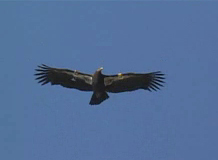
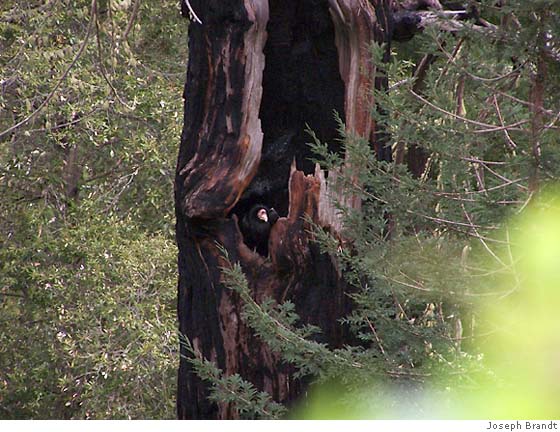


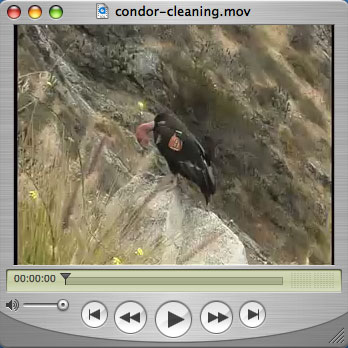

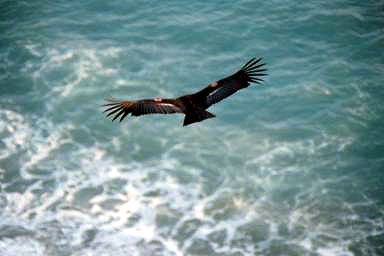

 As every month does, January has had its ups and downs, weather, condor, and people-wise. It has been a cold, mostly dry month. Not much actual rain, just a fog that weighs enough to fall, and temperatures hovering just above the freezing mark. We had our first snow of the season up on the ridge around 3000 feet, and the crew has become reacquainted with Mr. Heater (a propane heater) on those chilly backcountry nights. Thus we were caught a bit off guard by that rogue week of warm weather in the 70s. Sunburns and snow in the same month!
As every month does, January has had its ups and downs, weather, condor, and people-wise. It has been a cold, mostly dry month. Not much actual rain, just a fog that weighs enough to fall, and temperatures hovering just above the freezing mark. We had our first snow of the season up on the ridge around 3000 feet, and the crew has become reacquainted with Mr. Heater (a propane heater) on those chilly backcountry nights. Thus we were caught a bit off guard by that rogue week of warm weather in the 70s. Sunburns and snow in the same month!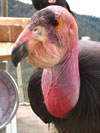 Our flock has strong promise of an egg this year, with the flock acting like teenagers at summer camp. Last winter we had the following condor pairs: 167 and 190, 208 and 168, 194 and 171. These condor couples are still together this year, and there have been signs of interest in the opposite sex among the younger birds as well. The condor's breeding coloration is beautiful, with a bright pink spot on the neck and purple-blue sides, as well as a brightening of the natural yellow and pink head. Female and male California condors look identical to us, but the condors sure know the difference! Stay tuned next month for (hopefully) some juicier condor gossip.
Our flock has strong promise of an egg this year, with the flock acting like teenagers at summer camp. Last winter we had the following condor pairs: 167 and 190, 208 and 168, 194 and 171. These condor couples are still together this year, and there have been signs of interest in the opposite sex among the younger birds as well. The condor's breeding coloration is beautiful, with a bright pink spot on the neck and purple-blue sides, as well as a brightening of the natural yellow and pink head. Female and male California condors look identical to us, but the condors sure know the difference! Stay tuned next month for (hopefully) some juicier condor gossip. The condor crew staff is changing. Mike Tyner rejoined us for the first half of January before being reassigned to the San Luis Reservoir Power Pole Survey. Our newest intern, Mr. Ryan Choi, hails from Bellevue, Washington. He graduated from Whitman College and comes to us fresh from the wilds of the Southeast Alaskan Flying Squirrel Project for the Wildlife Society. We're excited to have him and look forward to an exciting and fun season.
The condor crew staff is changing. Mike Tyner rejoined us for the first half of January before being reassigned to the San Luis Reservoir Power Pole Survey. Our newest intern, Mr. Ryan Choi, hails from Bellevue, Washington. He graduated from Whitman College and comes to us fresh from the wilds of the Southeast Alaskan Flying Squirrel Project for the Wildlife Society. We're excited to have him and look forward to an exciting and fun season.

